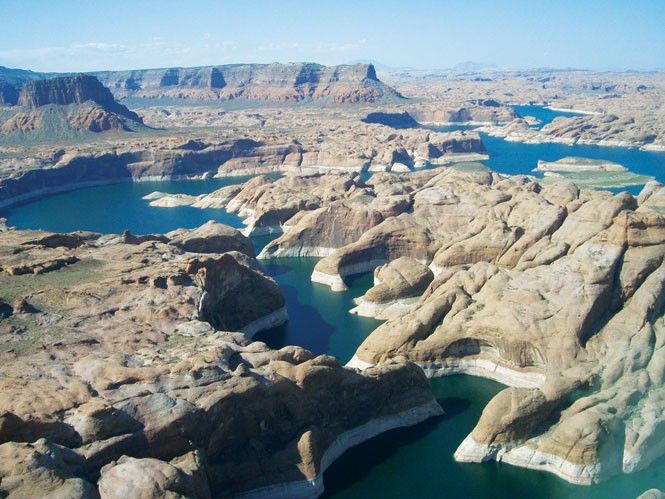
- Lake Powell
With California-like temperatures during a month-long chunk of winter, and a snowpack that on Feb. 1 was only 84 percent of normal, Utah and the West are once again speeding toward a year of hearty drought.
By midsummer, water woes will certainly be on the minds of anyone living in a desert community. But in Utah, a few things will most likely remain the same, drought or not: Utahns will remain among the most prolific water users in the nation. They will also continue paying bargain prices for their water, and the word "conservation" will be little more than a concept uttered in TV commercials.
Behind the scenes, and inside the granite fortress that is the Utah Capitol, lawmakers have long fixated on a couple of massive water projects that, while accomplishing nothing for the people who live here now, will—they say—provide water for the millions of Utahns predicted to arrive between now and 2050 or so, when state leaders say the state's population will double in size.
For state water managers, the crown jewels of future water supplies lie in the thinning snowpacks of the Uintah Mountains, where the Bear River originates, and in the vastly depleted waters of Lake Powell.
Both of the overtaxed Bear and Colorado rivers are ripe for Utah's picking. And proposals are underway that would affix a pipeline to each water system. The Bear would deliver water to the Wasatch Front, while the Lake Powell pipeline would stretch across 140 miles and deliver water to the booming desert town of St. George.
Skepticism about whether these projects, estimated to cost billions of dollars, are a waste of taxpayer money and whether the water they aim to deliver even exists outside of spreadsheets has been fodder for much debate.
But for the past 15 months, Utah's Office of the Legislative Auditor has been working on an audit that was called, in part, to investigate whether or not state water bosses are using bad water-use data to justify these costly projects.
In spite of the pending audit and concerns from residents, the Legislature, on the final day of its 2015 session, approved a bill that will create a fund for future tax revenues to be diverted to help pay for these pipelines and tens of billions of dollars in other water projects.
The bill's sponsor, Sen. Stuart Adams, R-Layton, said at a March 3 Senate committee hearing that "probably the only limiting factor to growth is water development."
Adams fielded the toughest questions not from critics of Utah's water policies, but from Sen. Allen Christensen, R-North Ogden, who said he couldn't figure out why Adams would create a fund that lacks any money to fill it with.
Earmark funds with no money, Christensen said, are typically closed, not opened.
"For the life of me, I don't see the purpose, the practical purpose, of doing this," Christensen said. "Establishing a fund with no money, it's like a homeless guy buying a wallet."
As the bill sped through the process in the final two days of the session, any concern about lack of money was quelled by a last-minute infusion of $5 million, which will be deposited into the fund in 2016.
Zach Frankel, executive director of the Utah Rivers Council, says the haste with which an unnecessary fund was created was done to pre-empt the audit. "We think it's a rush to get this bill passed before the audit comes out because the core of the audit is that the Division of Water Resources has been inflating future water needs specifically for Bear River development and the Lake Powell pipeline," Frankel said.
Additionally, Frankel says, once funds are created, they are difficult to close. The mere existence of the fund prior to release of the audit could make it easier for lawmakers to begin diverting ever-larger sums of money into the fund with less scrutiny, Frankel said.
One of those who voted against the bill in committee was Sen. Jani Iwamoto, D-Holladay, who pointed out that in the case of the Lake Powell pipeline—which would pump the water 2,000 feet uphill along its journey to Washington County—the depleted Colorado River is already over-allocated to users downstream.
Gabriel Lozada, an associate professor of economics at the University of Utah, said the state needs to deal with its "massive price distortion" when it comes to water before it builds any new projects. Because Utahns pay for water through their property-tax bills, the actual costs of water here can be masked. And because the price of water is a key ingredient to encouraging conservation, the thought goes that Utahns could conserve much more than they do if they actually paid similar prices as consumers in other Western states pay.
"The projections of need for massive new water projects in the state is not because of population growth, but because of the way that water is currently priced in Utah," Lozada said, noting that in St. George, a single penny buys 131 glasses of water, while in Tucson, Ariz., a penny buys 10 glasses of water. "What we need to do first is come up with a rational way of pricing water in Utah. That's the first necessity."